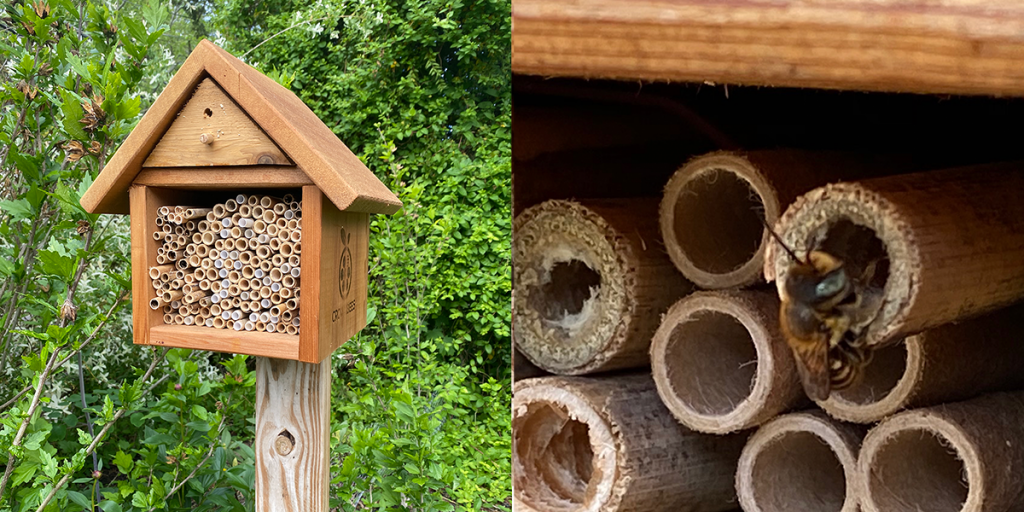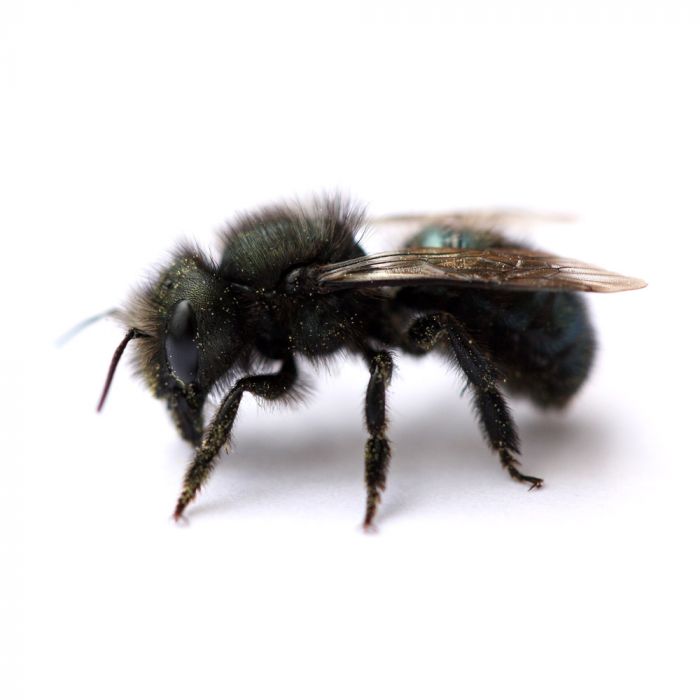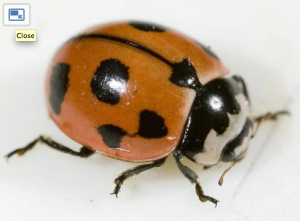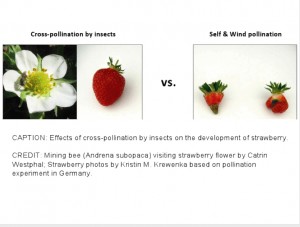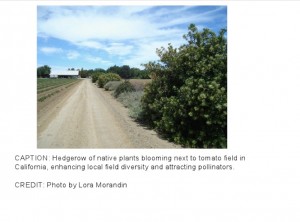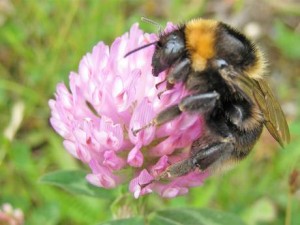A Midwestern beekeeper friend has earned his living as a migratory bee-farmer for almost 40 years; his son represents the fourth generation of this family to enter the beekeeping business. For most of those decades, the practice of migratory beekeeping was relatively trouble-free; the bees were not harmed by being trucked around America; there was no warning of impending disaster. All of that changed with the coming of the new systemic pesticides, the neonicotinoids.
During summer in the Midwest, colonies build-up on pollen from maize, and dandelions while gathering nectar from soybeans, alfalfa, clovers and linden trees. Sadly, the maize and soybeans are seed-treated with systemic neonicotinoid insecticides, which emerge later, in the pollen and nectar, to poison the bees. To make matters worse, later in the season, those same crops are sprayed with additional: fungicides, herbicides and insect-growth-regulators (IGRs). Combined with the systemic neonicotinoids, these react ‘synergistically’, to produce a witches’ brew of poison that is far more toxic than any pesticide on its own.
In early winter, American beekeepers load around a million beehives onto flatbed trucks and haul them to California, where they are parked in beeyards, to wait for the pollination of the almonds in February. Almonds make up more than 825,000 acres of California’s Central Valley generating more cash than both the California wine and tourism industries combined. The almonds form a vast mono-culture, and once the trees have blossomed, the entire area is almost devoid of: wildflowers, bees, insects or birds.
It is hard to judge whether the bees are poisoned more, by the summer neonicotinoids which affect them in the Midwest, or if they are finally pushed over the edge in the winter, by having to eat pesticide-contaminated stores. Either way, for months on end, these bees are exposed to a repeated drip-feed of many different pesticides.
For many migratory-beekeepers, the ‘coast to coast’ persistence of systemic pesticides is the final straw. More than 240 million acres of American corn, soya, canola/ oilseed rape and cotton were treated with neonicotinoids last year. There is literally ‘nowhere left to hide’ that is free of hyper-toxic, systemic, highly persistent, bee-killing pesticides.
In California, according to USDA figures, more than 20 million pounds of: insecticides, herbicides and fungicides, were applied to 825,000 acres of almonds in 2011. Different mixtures were used on up to twenty applications in one season. The average annual pesticide-application-weight is thus about 25 pounds per acre. The USDA report confirms that, since 2001, over 200 million pounds of pesticides have been applied to these same almond groves. The majority of these are applied in the weeks before the bees arrive, so they do not harm the incoming bees; however, there no ‘native’ Californian bees are able to survive among the almonds.
Since 2003, more than 10 million American bee colonies have died; however when ‘running replacements’ are taken into account, it is possible that as many as 20 million may have perished. Twenty years of peer-reviewed studies indicate that the hyper-toxic, systemic, neonicotinoid insecticides, are the only logical explanation for this global bee-extinction.
Beekeepers in the UK, who often keep just one or two hives, may find it impossible to grasp the scale of the disaster that has befallen America’s bee-farmers. The following photos and personal report reveal the enormity of this bee-holocaust, which is driving many commercial beekeepers into bankruptcy.
My correspondent in California wrote to me on February 5th 2013:
“I thought I’d give you a ‘behind-the-scenes’ look into the death of my bees in California. I started out last spring in the Midwest with 3,150 healthy bee colonies; of which 992 still survive, and most of those are very weak. More than 2,150 of my valuable bee colonies are now extinct.”
Each dead colony means a loss of between $200 and $300 depending on the timing of the loss; it can cost $200 to buy and establish a new hive of bees. Dead bees do not pollinate flowers or fulfill pollination contracts! Almond-growers can lose as much as $4,000 gross income per dead hive, since their almond crop remains un-pollinated. The enormous sums of money involved pose an imminent threat, not only to the bee-business but also to the entire almond industry.
2,150 DEAD BEE-COLONIES
“This should be the busiest time of my year... however, since I have lost 2,158 hives in less than a month to ‘colony collapse disorder’ I have had to withdraw from a 1,200 hive pollination-contract, which means I have less work at present. The cold California weather has also delayed things; it will be two weeks before we see the first almond blossoms. Frankly I’m spinning my wheels and fighting depression, I need to get busy…”
In years gone by Almond Growers applied ‘hard’ insecticides as sprays during the ‘dormant’ winter season – when there were no flowers or bees present. This presented few problems unless the beekeeper brought them into the orchards too early from his over-wintering yards. Nowadays these ‘dormant-period sprays’ are almost a thing of the past as ‘softer’ insecticides and insect-growth-regulators are being used. Farmers mix: insecticides, fungicides and growth regulators in a single ‘tank mix’, which is applied while bees are actually in the orchards and the trees are in full bloom. If these pesticides are applied at night, there are relatively few acute deaths among the adult bees; however the combined effect of these sprays on the general fertility of the colony can be severe; we often notice ‘brood disruption’ two to three weeks after the pesticides are sprayed.
The application of these ‘tank mixed’ insecticides and insect-growth-regulators may not kill forager bees outright, especially if applied at night; but at sub-lethal levels they damage the nurse bees’ ability to feed the young larvae; so the population of the hive shrinks as old bees are not replaced. Moreover, ‘insect growth regulators’ are applied to the trees, to disrupt the growth of target-insects but these hormones also have disastrous effects on bee-larvae, preventing them from moulting or completing metamorphosis.
Depending on the weather, bees may be exposed to as many as six spray-episodes, while among the almond blossoms; each spray contains a different mixture of insecticides, herbicides, insect-growth-regulators, fungicides, surfactants and adjuvants. The combined poisons prevent the bees rearing much of the brood into workers. If almonds are the only crop being pollinated this ‘lack of brood’ phenomenon may only last a few weeks and then clear up, when the bees are moved away to pesticide-free crops.
Poisoned Cherries
Unfortunately, when bees are moved away from the almonds, they are then exposed to additional waves of pesticides among the cherry, apple, and blueberry orchards, where they are taken to fulfil other pollination contracts.
Among the fruit crops, the bees are then exposed to as many as three additional fungicide or insecticide sprays. This additional pesticide-stress, means it takes even longer for brood-production to return to normal. To make matters worse, some orchards grow beside walnut-groves, which are sprayed with ‘insect-growth-regulators’ during bloom-time. These hormones also poison bee larvae and brood; so depending on the time of application and the wind direction, hives can suffer further serious damage from this additional pesticide exposure.
Pesticide-Free Foothills
In late March, the surviving colonies are withdrawn from cherry-pollination and moved into the California foothills, to forage on natural clover and wildflowers. While resting there, the beekeepers split colonies into two halves, in order to make new hives and hopefully rebuild from the season’s colony collapses.
Late April – Return to the Midwest
In late April beekeepers load the beehives onto trucks and haul them back across America to the Midwest, where they remain for the spring, summer and fall. Colonies build-up naturally in spring, as warmer days and blossoms stimulate the bees. Colony-growth and expansion may take-off as early as April 1st, but often this is still too cold. For this reason Midwestern beekeepers try to time their arrival home for late April, to catch the abundance of ‘late’ tree pollen, and the start of the dandelion-nectar flow. The bees really love the abundance of dandelion pollen and nectar; in the past, these were excellent for building-up colonies, but sadly, it has been ten years since bees have built-up normally on dandelions.
Midwest Corn and Soya: Contaminated with Neonics
The Midwest has a very diverse geography and climate: Minnesota, Wisconsin and North Dakota are far enough north, that growing corn there was once considered a ‘marginal’ activity. However, America’s obsession with fermenting corn to make ethanol fuel, has changed everything. ‘Corn is now King’ over much of this vast area.
Over 90% of all corn in the Midwest is seed-treated with the systemic neonicotinoids Clothianidin and Thiamethoxam. In 2011 the USDA reported that 92 million acres of American maize were seed-treated with Clothianidin, which emerges in the pollen, making it highly toxic to honeybees.
Amish farmers can even be seen planting GM/ neonic-coated corn. It is a bizarre sight to see a team of Amish horses pulling a sprayer with a gasoline-powered pump, spraying roundup weed-killer on the GM/ roundup-ready corn.
During planting, Neonic-treated corn/ maize often produces a ‘minor bee-kill’ at hive entrances; but this is deceptive. The sprinkling of dead bees found in front of such hives is just the tip of the iceberg In truth, exposure to neonic-contaminated planting dust from corn may kill as many as half of all the workers in each hive; this causes a dramatic fall in foraging activity. Most neonic-poisoned bees die in the field, well away from the hive; unable to find the way home, they vanish without trace.
If one studies the ground in front of such hives, it becomes evident that the alleged ‘short-term’ bee-kill, associated with planter-dust, is in fact long-lasting. Some bee-corpses found in the grass are already decayed, while others seem to be ‘only just dead’ and can be ‘resurrected’ by tickling them with a blade of grass. This causes them to attempt feeble movements; ‘spastic’ is the word which best describes their feeble trembling.
The unusual thing about the survivors, is that they are mostly very young workers, probably ‘nurse-bees’. A heavy exposure to neonicotinoids via planter-dust may be acutely toxic, killing forager-bees outright; however, a weaker dose can induce sub-lethal poisoning, killing the bees more gradually. Nevertheless, the neuro-toxin still affects them strongly; if they show clear signs of poisoning, the guard bees will not allow them into the hive, and the outcasts just crawl away to die in the field. Bees, whose nervous-systems and navigation are badly affected by a stronger dose of neonicotinoids, never find their way home.
Most of the bees found dead at the hive entrance are abnormally-young; the bees normally seen at hove entrances are tough old guard-bees, or mature foragers. Young nurse-bees appear ‘soft and fuzzy’ since they are covered in fine hair, which is gradually lost, as work takes its toll; adult foragers look harder-edged: the thorax is hard and polished. Likewise, while the wings of young nurse bees shine with perfection, the wings of old-foragers look tattered and frayed.
Nurse bees are too immature to be assigned foraging duties outside the hive so they are not being poisoned by contact with pesticides in the field. They are exposed to neonicotinoids via contaminated pollen and nectar brought back to the hive by adult foragers. The nurse bees digest this pollen and nectar in order to secrete ‘brood food’ for larval bees; thus they are slowly poisoned before they graduate to foraging duties outside. Instead, these poisoned nurse bees crawl out of the hive entrance to die a slow, spastic death.
Loss of Adult Forager Bees Triggers a Colony Crisis
Many studies confirm that if the hive loses its adult foragers a ‘colony-development-crisis’ ensues; the loss of mature workers forces the dwindling colony into an ‘emergency reaction’; immature nurse-bees are pushed outdoors as ‘precocious foragers’ while still too young for this work. Their lifespan is severely shortened and they die early, speeding the collapse of the colony.
Pesticide-induced depopulation happens early in the season, when temperatures are gradually rising, so a hive may often recover from this early setback; many of the weakened colonies have just enough bees left to keep the brood warm. Thus, once the acute pesticide-exposure, from the planting of neonic-treated crops lessens, fresh, the hive gradually recovers, as pesticide-free sources of pollen and nectar become available from wildflowers or other crops.
Neonicotinoids Trigger Abnormal Queen Replacement
A very abnormal phenomenon associated with early-season-pesticide-poisoning, is that many colonies will suddenly kill, or ‘supercede’, their existing queen. Supercedure is a natural process, by which bee colonies replace an ageing-queen, as her fertility fades; it usually happens when she is two or three years old. The colony then produces a number of new queen cells, or a single ‘supercedure’ cell, in mid-season. Supercedure, of current-season queens, early in the year, was considered extremely unusual before the advent of neonicotinoids; but many beekeepers report that this is now common. Abnormal supercedure of young queens is exactly what one might expect, if they have been fed neuro-toxins via contaminated pollen and nectar.
A queen must eat her own body-weight in food every day, in order to lay 1,500 or 2,000 eggs. Thus she consumes hundreds of times more food than a worker and can live for three years, as opposed to six weeks; thus her exposure to neonicotinoids, or other pesticides, may be greater than that of a worker bee or nurse bee.
Thus, early-season pesticide-exposure causes abnormal brood-mortality, which disrupts the ratio of capped-brood to open-brood in the hive; once again, this encourages the bees to supercede the queen because it all ‘feels wrong’. If workers sense that a queen is ‘abnormal’ in any way, this can trigger immediate queen-replacement. If her pheromones are perceived to be weak; if the rate of egg laying drops-off; if she trembles on the comb – she will be killed at once. However, if a colony supercedes the queen in early summer, there will be a month-long-gap in egg laying and brood production, since it takes about four weeks for a new queen: to be produced and mated, before she can lay new eggs. A pesticide-affected colony, which supercedes a young queen, will never catch-up with a healthy hive, which has maintained its queen through a season of continuous brood production. Such abnormal-supercedure colonies will make little or no surplus honey.
The Main Midwest Honey Flow:
In the Midwest the main honey-flow usually starts in early July. The bees gather most of the nectar from a mixture of clovers and basswood, or linden trees.
Soybeans: Three Routes of Exposure to Neonicotinoids
The first wave of pesticide-exposure comes in late July, from insecticide sprays used to control aphids on soybeans. This exposure route is complex; most American soybeans are coated on planting, with the same mixture of neonicotinoid insecticides and fungicides as is corn. However fewer mass bee-kills are observed among soybeans at planting, since far-less pesticide-contaminated dust, rubs off the soybean seeds than happens with corn. It should be noted that the neonicotinoid coating, which abrades from the seeds, is thousands of times more concentrated and poisonous than the greatly diluted version which finally emerges in pollen and nectar.
The pesticide coating sticks much better to the smooth, egg-shaped soybeans, than it does to the rough and angular corn seeds; so less pesticide rubs off the soybeans to contaminate the planter-exhaust dust; this is very different to what happens with corn. Also, since most soybeans are planted with a soil-drill, and many do not use compressed air to distribute the seeds, there is far less pesticide-laden exhaust dust.
Second Phase of Neonicotinoid Exposure
Bees feeding among the mature soybean crop are then exposed to pesticides via a second route, when the neonicotinoids, originally applied as a seed-coating, finally emerge in the pollen and nectar of the blooming flower.
Third Phase of Pesticide Exposure
A third pesticide-exposure route associated with the soybean crop, is caused by later application of different insecticides, applied as foliar sprays.
A Pesticide ‘Free for All’
Since the American EPA has abandoned any pretence of enforcing pesticide label regulations, farmers can apply insecticides virtually anytime on a ‘perceived need’ basis: 24 hours a day, 7 days a week, 365 days a year;.
Soaring commodity prices and high-pressure salesmanship from pesticide companies means that, farmers mostly opt to treat their crop with insecticides ‘prophylactically’ (as an ‘insurance measure’), rather than in response to a real invasion of insects. In order to maximise the lethal-kill-period of the pesticide, most of the insecticides used are classified as: ‘Extended Residual’, designed to persist and remain lethal in the crop for several weeks. A pesticide-cocktail is applied as a single tank-mix; commonly this will include Chlorpyrifos combined with Lambda-Cyhalothrin, mixed with a sticky fluid and adjuvant. Crop-consultants advertise that this will continue to kill insects for up to 21 days, and they are most often applied while the crop is flowering, in the heat of the noonday sun – when bees are actively foraging.
Negative Effect of Pesticides on Honey-Production
In the summer of 2012 some neighbouring Midwest beeyards produced wildly varying crops of honey; some poor-producers averaged just 70 pounds of honey per colony, while adjacent yards produced over 140 pounds. The only explanation is that tracks from pesticide spray-rigs could be seen in the soybean crop around the less-productive beeyards.
Neonicotinoid Treated Corn
Immediately after the soybeans finish flowering, the bees suffer another major pesticide-exposure, when the corn tassels shed their pollen. Midwest corn fields often form vast mono-cultures, covering thousands of acres; in such areas bees are forced to harvest pollen from corn, as the only source available. Corn pollen from seed-treated corn contains neonicotinoid insecticides. For the last couple of years, some Midwest corn fields have also been sprayed from the air with fungicides, during the pollen-tassel phase. So bees gathering corn-pollen receive a double-dose of neonicotinoids and fungicides at the same time. Shortly after this aerial spraying of fungicides, bees suffer another break in the brood-rearing-cycle. The collapse of brood-production could not come at a worse time in the season, when hives should be raising thousands of healthy young worker bees in preparation for winter.
‘Winter Bees’ Vital to Colony Survival
As colonies prepare for the winter, they deliberately reduce the hive population. Worker bees only live for six weeks, so a bee that is born in summer cannot possibly survive until March. In order to get around this problem of bee-longevity, the colony produces a generation of ‘winter bees’ in early autumn. These young bees have little work to do, since there are no flowers to harvest –and all the honey has been processed and stored. Consequently they do not work themselves to death in six weeks, as is normal, but instead are tasked with keeping the queen warm and alive during the long winter months. The colony also enacts a ruthless ‘winter-fitness-selection’ on itself: worn-out old bees are expelled, or leave voluntarily, since they would just consume valuable food supplies and die anyway in mid-winter. Only the young are allowed to stay with the queen.
Male drones are evicted from the hive to starve and die; many of the older workers leave instinctively, sensing that their time has come. This ‘natural selection’ has evolved to ensure the hive is stocked with lots of healthy young ‘winter-bees’, to survive the winter months. At all costs, the colony must maintain a critical thermal mass if it is to survive the winter; if the population is too small to maintain this temperature, the colony dies.
Thus, repeated pesticide-shocks throughout the growing season trigger the collapse of brood rearing in late summer. As a result, the colony does not produce enough young worker bees and, in desperation, worn-out worker bees are retained in the hive beyond their normal residency. To the untrained eye, the colony still looks well-populated and has plenty of honey and bee-bread for the winter. But in reality, this colony of geriatric bees is doomed to collapse in mid-winter.
Neonicotinoids increase pathogens and parasites
Neonicotinoids are known to weaken bees’ immune systems, making them more vulnerable to: parasites, viruses, bacteria and fungal disease, (Pettis. Engelsdorp & Alaux). A colony may appear to collapse as a result of varroa, viruses, bacterial disease or nosema infection, but the underlying cause is arguably the destruction of the bees’ immune system by minute amounts of neonicotinoids.
As noted above, in pesticide-affected colonies, ‘older’ worker bees are abnormally retained in winter to bolster the population. It is logical that these ‘geriatric’ winter bees already have a weakened immune system – due to age and sub-lethal exposure to neonicotinoids; but they also carry a lifetime’s load of parasites and pathogens when they go into the winter-hive. Months of close-quarter-living, within the winter cluster, provides perfect conditions for diseases and parasites to grow, triggering colony collapse. Newly-bred winter bees would carry a far lower burden of parasites and diseases, since they are too young to have acquired them.
What we observe, repeatedly, is a gradual decline in colony-strength, which accelerates as the cluster shrinks. Eventually the colony falls below a critical thermal mass, collapses and dies.
This bee-farmer’s photographs record the disaster: of 3,200 bee colonies which he brought to California on November first, just 900 remained alive on February 5th.
Moreover, there is no guarantee that these 900 remnant-colonies will even survive to return to the Midwest, because they have not yet been placed among the almonds, where they will encounter further waves of pesticide-stress in late February. They will then endure even more pesticide applications among the cherry, apple and blueberry crops. So the prospect of this bee-farmer salvaging anything from this catastrophe does not look good. The wider implication is that his personal tragedy is being repeated on a far, far greater scale, among the thousands of other bee-farmers, who have brought over 1.5 million hives to California. It looks like 2013 may prove to be a historic watershed for the almond industry, as the year in which there were simply not enough surviving bees to pollinate the vital almond crop. Whether this bee-farmer can survive to rebuild his devastated business is an open question that will only be answered in the coming months.
NOTES FOR THE ARTICLE
http://www.cdpr.ca.gov/docs/pur/pur10rep/comrpt10.pdf
Table 20: Total reported pounds of all Active Ingredients (AI), acres treated, acres planted, and
prices for almonds each year from 2006 to 2010. ‘Acres treated’ means cumulative acres treated i.e. 1 acre treated 10 times = 10 treated acres.
In the table above – 825,000 acres of Almonds were treated with 20,498,411 pounds of pesticides in 2011, which means that in a single growing season, each acre of Almonds received 24 applications of different herbicides, fungicides and insecticides. Each acre of almonds received almost 25 pounds weight of pesticides in just one year. Many of these pesticides have a high persistence in soil and water. By extension, roughly 200 million pounds of pesticides have been applied to this patch of California in just ten years. Where did all that poison go to? Where did it end up? In the streams, watercourses, ditches, ponds and rivers of California.
